- +212 698 193 183
- info@specialmorocco.com

CloseWelcome

The itinerary below is only one of many possibilites that is offered as an inspiration. We can tailor-make your trip based on your needs. Send us details of your preferences and our travel experts will customize this trip to suit your interests, tastes, and budget.
Once you land at the airport in Marrakech in the morning local time, we will drive directly to your hotel and check if the rooms are ready. After lunch (optional), enjoy spending the rest of the day relaxing in this ancient royal town, founded in 1062 by the Sahara Almoravid dynasty. Even today, the name of Marrakech is associated with events of “One Thousand and One Night’s Adventures”: narrow alleys, souks, sales stalls, and markets. For curiosity, take a stroll through the Medina of Marrakech. You will get a good impression of the city here on your first day in Marrakech as you take a horse-drawn carriage ride inside and outside of the city walls. On your journey, you will capture the beautiful Majorelle Garden, which until 2008, until his death, was maintained by the internationally renowned stylist and fashion designer Yves Saint Laurent. His urn has been buried in the garden, and you can visit the grave. After a long day with an early morning start, you will embark back to your hotel, have a sound sleep.
 Meals provided: breakfast
Meals provided: breakfast
To start your day, there is a visit to the famous Koutoubia Mosque. Its majestic silhouette can be seen from miles around. The minaret of the Koutoubia Mosque was completed in 1147 after the city was taken over by the rival Almohad dynasty. It is considered to be a true masterpiece of Islamic architecture and an example of which other mosques have been inspired. For example, the great mosque in Seville (called La Giralda) and the Hassan Tower in Rabat are almost identical. From there you will be driven to the Saadian tombs. Once sealed off and hidden after the fall of the Saadi Dynasty, which ruled from 1549-1659, the tombs were only rediscovered in 1917. This was built in the 1700s on top of the remains of the former dynasties’ burial sites. Here you will visit the three separate mausoleums with gold-plated columns and marble arches, as well as the garden symbolizing eternal paradise. You will then go on to Bahia Palace, which is considered one of the grand palaces of the Moroccan city. You will be mesmerized by the 150-room palace which was home to the slave-turned-vizier Abu ‘Bou’ Ahmed. After lunch (optional), you will continue on to explore the unique Jemaa el Fna Square with its live folklore. The place is a true showcase for Moroccan traditions and is on UNESCO’s list of world heritage sites. Every day there is a large market where you can buy herbal medicine, freshly squeezed orange juice and a sea of nuts, dates and traditional cakes. From Jemaa el Fna you will venture to the traditional markets to a colorful array of items from for leatherware to spices before returning to the hotel.
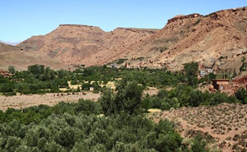 Meals provided: breakfast and dinner
Meals provided: breakfast and dinner
After breakfast, your day will start with a visit to the small town of Zagora, also called the “Gate of the Desert”. You will cross the magnificent Atlas Mountains, across Tiz’n’Tichka, which with its 2,606 meters is the highest mountain chain. The road over the Pass was built in the 1920s by the French colonial empire. It offers a landscape that alternates between dry and mineral-rich mountainsides over snowy peaks to lush valleys with red clay houses. Late in the morning, you will reach the other side of the Atlas Mountains, to an area also known as the “Gateway to the so-called Great South, Oases, Sahara, and mountain cliffs”. This part of Morocco is the birthplace of many royal dynasties. A drive through the Draa Valley, where you will experience fortified villages, where the people live as if time stood still, a hundred years ago. It’s a pearl of beautiful oases. The road south of Ouarzazate leads us across the desert plateau at Jbel Tifernine, which then changes to black rock formations and cliffs as the drive climbs the Tiz’n’Tinififft Pass. After a short break at the small Berber town of Agdez, located at the edge of an idyllic palm land, you will continue south towards Zagora. Along the way, the drive will past a row of oasis and impressive kasbahs, such as the elegant and well-preserved Timed Kasbah. In the afternoon you will arrive in a small town in Zagora. From the outskirts of civilization as we know it, and just a few kilometers from here, begins the mighty Sahara Desert. Upon arriving at Zagora you will stay and gather for a hearty dinner.
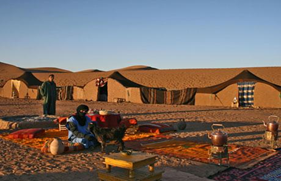 Meals provided: breakfast and dinner
Meals provided: breakfast and dinner
After breakfast, you will enjoy today’s adventure in the desert. Here you head south along the road past the fortified little village of Tamegroute, where a group of Islamic scholars founded a school back in the 1800s. This school and its library are still in use, although it’s in no way comparable to the greatness of the past, where it was the source of inspiration for much of southern Morocco. Later, there is a special visit to a local family in their home, in another small village called Tagounite. This would be a highlight for anyone visiting, as you will have an opportunity to see and experience the life of Moroccans in the countryside. Enjoy a tour of their home, sit back to enjoy some tea and coffee, and learn more about their life. After the family visitation, you will travel onto Sahara, where you will experience the amazing Sand Dunes at M’Hamid. This is the absolute last village that can be reached along the asphalt road, giving you the feeling that you have reached the end of the world! After lunch (optional) you will be taken by jeep to travel further into the desert, where there is now the possibility to go for a dromedary ride. (The cost is not included in the tour. If you want to experience the dromedary ride, tickets can be bought on site. Price approx. 150 dirham per person.) Late afternoon you will reach your accommodation in the desert, and spend the night in a real Bedouin tent camp. Here you will experience dinner under the open and star-red sky, surrounded by candle lights where you can sit back, relax and be entertained by local desert musicians.
This is the Real and Authentic Thousand and One Night’s Adventure!
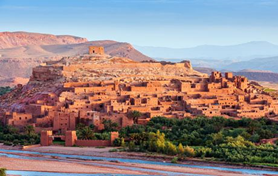 Meals provided: breakfast and dinner
Meals provided: breakfast and dinner
An early morning rise to soak in the awesome sunrise before breakfast. Afterward, you will continue to Ouarzazate, originally founded by the French Foreign Ministry in 1928, because of the strategic location at the intersection of the Draa and the Dades Valley. On the way, you will visit Morocco’s most impressive Kasbah complex at Aït Benhaddou, which scenes for numerous Hollywood productions from Laurence of Arabia, to Nilens Jewel and Gladiator were filmed. The Aït Benhaddou Kasbah, which is on UNESCO’s list of World Heritage Sites, is set in a bright reddish sandstone hill overlooking the Mellah River. After lunch (optional) at a local restaurant with panoramic views of the Aït Benhaddou Kasbah, you will continue to Ouarzazate, where you will stay the night. The rest of the day is for you to enjoy, to relax by the swimming pool, or for you can wander nearby. Your tour guide will offer you good advice and ideas.

Meals provided: breakfast
After some enriching days in Morocco’s “Great South” you will return to Marrakech over the beautiful Tiz’n’Tichka Pass, which would be covered in white due to the snow during this time of the year. Upon your return to Marrakech, you can rest at your hotel, or explore some sights or markets. Your tour guide can give you some suggestions on how you can spend your evening.
 Meals provided: breakfast
Meals provided: breakfast
Free day for you to discover again the colorful market and to do any last-minute souvenir shopping. In the evening a farewell dinner has been arranged. You will have an optional dinner and will be picked up and taken to an old 19th-century palace which has been transformed into a traditional Moroccan restaurant. Here you will enjoy a sumptuous meal and lively entertainment of traditional dance and music. A great way to end your Morrocan trip!
Sadly, after breakfast at the hotel, your transfer to the airport is awaiting.
DELLAROSA HOTEL **** :
In the heart of the ochre city, in the popular Hivernage district, the Dellarosa Boutique-Hotel and Spa enjoys an exceptional geographical location. Close to all major points of interest including the centre of Guéliz and only a 10-minute walk from the famous Place Jemae El Fna, its souks and its extraordinary medina. Our hotel offers an exclusive setting and a 360 ° view of the Atlas Mountains for a charming or business stay in Marrakech. The decoration is contemporary, perfumed with elegance and sobriety, under the influence of Moroccan and oriental craftsmanship, enlivened by two restaurants, a lounge bar, a swimming pool, a spa, a sky, a shop, terraces … Between comfort and conviviality, Moroccan hospitality takes all its meaning and each guest is welcomed in the respect of local traditions.

Location : Google Map
LA PETITE KASBAH ** :
La Petite Kasbah is an old house belonging to the family of Brahim, manager and current owner of the latter. It is also his birthplace. The Kasbah has undergone a total renovation for many of its parts. The renovation began in 2007 and was completed in 2009 (2 years of work). The completely renovated Kasbah opened its doors in March 2009.
I am a very easy going person. I like to make jokes and live my life smiling. All my life I have been working with the tourism industry and after 15 years of hard work I managed to open my own hotel.
Our neighborhood is very special. We are located at the entrance of the huge Palm Trees of Zagora. Very accessible by car, bus or even by foot. Our area is one of the biggest oasis of Morocco.
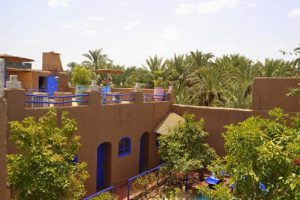
Location : Google Map
ERG LIHOUDI DESERT CAMP *** :
Camping within Morocco Desert is an adventure that everyone should have at least once in their life times, the Erg Lihoudi standard desert camp near Ouled Driss and the trekking with camel excursions greeted invite you to indulge yourself in the real desert world of bedouin nomads with their culture and lifestyle. It is an experience and the chance to live unforgettable moments in these magnificent hinterland and vast. Erg Lihoudi standard desert camp offers an unforgettable stay Include activities for those guests who like to get away from the bustle and hustle of the big cities. Our Erg Lihoudi Standard Desert Camp is located 07 kilometers from the village of Ouled Driss, at the beginning of the great sahara desert In southeastern Morocco. The camp is in the desert, well equipped with a sanitary block, hot showers and western-style toilets. Water and electricity are powered by solar panels. In the center of the camp, a Big Nomadic tent, covered in traditional berber carpets, welcomes you with relaxing and comfortable seating under the starry sky around a campfire. A large shared room is available to all, where Moroccan meals are served. The food, based on local and organic fresh products, is provided by our camp chef. Serenely we look forward to the pleasure of welcoming you with the saharan traditional hospitality tea served upon your arrival.

Location : Google Map
DAR CHAMAA *** :
It is our wish to make your stay at RIAD-HOTEL DAR CHAMAA one truly memorable experiences, for which we count on our extraordinary staff who will be at you entire disposal during your time at our hotel. Built in a similar way to a former KASBAH (buildings constructed with mud and with towers in the corners) the interior design displays a central court with a fountain surrounded by an archway. Located in a privileged environment inside Ouarzazate’s palm grove, our guests will enjoy magnificent views of the Atlas mountains.

Location : Google Map
Start your day with a Private Guided Tour at Les Jardin Majorelle, the French painter Jacques Majorelle (1886 – 1962) dedicated forty years of his life to the creation of the luxurious gardens and Berber museum. An amateur botanist, Majorelle included plants from all five continents in the gardens. Marjorelle’s studio, a Cubist style villa constructed by architect Paul Sinoir, has since been transformed into the museum, and is painted a vibrant blue. The garden covers two and a half acres, and was opened to the public in 1947. The garden has been open to the public since 1947. Since 1980 the garden has been owned by Yves Saint-Laurent and Pierre Bergé. After Yves Saint Laurent died in 2008 his ashes were scattered in the gardens. The garden also houses the Islamic Art Museum of Marrakech, whose collection includes North African textiles from Saint-Laurent’s personal collection as well as ceramics, jewelry, and paintings by Majorelle.
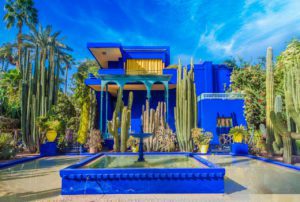
A private visit to the home of the late Yves St Laurent, the Villa Oasis. Yves saint Laurent travelled here each year to gain inspiration for and design his future collections. These inspirations saw him pay tribute to artists in his haute couture collections with the famous Mondrian dresses, then in 1966 with the pop art dresses and in 1967 with his major homage to Africa. In the 1970s he presented his Picasso and Diaghilev collections and tributes to Matisse, Cocteau, Braque, Van Gogh, Apollinaire in the 1980s.
After his retirement Yves Saint Laurent devoted his energy to the activities of the Foundation Pierre Bergé-Yves Saint Laurent, with the mission is to conserve 5,000 haute couture garments and 150,000 accessories, sketches and other objects making up the collection, to organize thematic exhibitions on fashion, painting, photography, the decorative arts, etc., and to support cultural and educational activities.
The Villa oasis still houses many of these collections and this a rare opportunity to gain insight into the extraordinary talent of the designer. The fee for the visit is a direct donation to the foundation to ensure future talents both in Morocco and abroad.
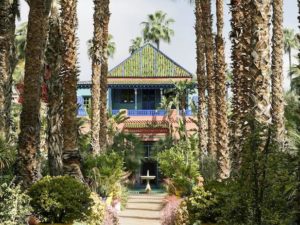
Enjoy a hosted visit by the gallery representatives & curators of the Maison de la Photographie of Marrakech is a courtyard mansion and is a private foundation created by Hamid Mergani and Patrick Manac’h in 2009.
Designed to create an archive of and showcase the diversity of Morocco as it was seen by those who visited it, anonymous travelers or famous photographers, over the last 150 years or so. Of visit is the documentary on Berber life by Daniel Chicault, shot 1956, runs on a loop on the second floor.

Rocco Orlacchio of Voice Gallery offers a private showing as well as a visit to the Atelier of a well renowned Artist in Residence Eric Van Hoven. Rocco sits on the board of the Marrakech Biennale and is the prefect ambassador to shed light on the Moroccan art scene. Voice Gallery showcases local and international, mainly young artists, who come together create and collaborate with each other, extending boundaries and exchanging ideas annuitizing the culture and landscape of Morocco to inspire their artistic endeavors.

Calligraphy means “beautiful writing” and Arabic calligraphy (or more properly, Islamic calligraphy) is considered a high art form in the Arab world and is increasingly gaining recognition and appreciation worldwide.
Abdeljalil conducts calligraphy workshops to share his passion with others. Whether you ask him about history or more practical information such as the ink or the pens, he will not skimp on precious information that may just leave you speechless. Patient and devoted, he will also teach you how to write the alphabet, your name and help you become familiar with calligraphy. After all, his life motto is “Make a living from a passion”.
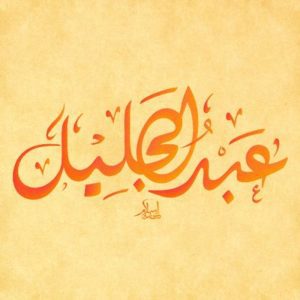
Private Cooking Lesson is at Le Maison Arabe. The workshops are conducted by a dada (traditional Moroccan cook) or a chef from our Moroccan restaurant, using easy-to-use modern equipment found in everyday kitchens. At the end of each workshop, participants dine on the meal they have prepared. At a typical half-day workshop, one learns to prepare an appetizer and a main dish, or a main dish and dessert.

The cooking class takes place in the Amizmiz Valley, populated by Berbers who still stick to their traditional way of life. Just a short ride from Marrakech this valley has been little affected by tourism. His elegant eco-farm is set amongst 15hectares of olive groves, vegetable gardens and orchards in a traditional Berber hamlet with the imposing silhouette of the High Atlas Mountains dominating the landscape. He will teach you how to utilize herbs and spices as well as prepare a typical Moroccan meal including bread making Moroccan style
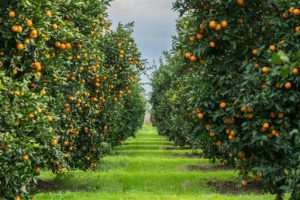
Tasting Marrakech is a tailor-made food and cultural experience that takes place in the famous Jemaa el Fna square in the company of a state-approved guide and a foodie expert. The tour is private and customized to your appetite and palate. Dine with the locals while sampling regional specialities at the most popular food stalls in the market while soaking up the night-time ambiance in the famous square.
Once you have had the opportunity to try the various street foods, we then take over a local restaurant close to the Jma El Fna and re-create what we’ve tried en route!

Start your day trip with a wine degustation at Val Du Argan, one of the leading wineries in the south of Morocco.
Moroccan-French born Charles Mélia, owner/winemaker, moved to France to manage his family’s property in Cotes Du Rhone at young age before turning back in his late 40’s to make wine in his motherland. His vineyard began with five tentative hectares planted in 1994 and now extended to 40, and still remains the only winery situated on the southern coastal part of Morocco. His boutique wines are now a reference point for the Moroccan wine industry.
Following the wine tasting stop en route for a cheese tasting and lunch at La Fromagerie where Jaouad Hbib and Abderrazzak Khoubbane run a seriously good dairy. The cheeses are made from old Berber techniques and each cheese reflects the unique vision of the farm in offering bio-made produce at high quality levels.
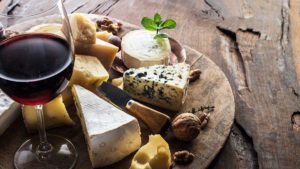
Drift gently over the fantastic desert landscape and capture the sunrise while floating over secluded Berber villages and the snow-capped Atlas Mountains on this magical balloon flight. Rides are available with groups or can be arranged privately with champagne breakfasts following the flight for that extra special occasion.

Enjoy a fantastic experience with gentle and well-trained horses riding through the local Berber Villages. All levels are catered for as the guide will adapt to your riding experience.
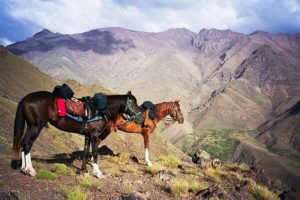
The Moroccan tradition of Hikayat, or storytelling dates back almost 1, 000 years. Some stories were recorded and other stories are passed orally. This form of entertainment was found in cities throughout Morocco but today Marrakech’s Jemaa El Fna square is the only city that’s keeping this tradition alive. This evening enjoy a private session of this dying artin the comfort and peace of your hotel with the master Storyteller Ahmed Ezzarghani in both Arabic and English before dinner.

Unlike the dunes of the Sahara Desert which take hours to reach, the Agafay with its stony hamada style desert offers a stunning landscape to relax, unwind and watch the setting sun – you’ll feel a world away from Marrakech even though it’s only a 45-minute drive. A gorgeous dinner in a camp setting with traditional musicians and campfires, overnight stays and daytime activities can all be arranged for those seeking a desert like experience without the long travel.
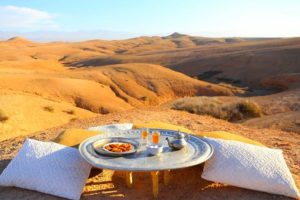
Head this morning to visit the village of Imlil at the base of Jebel Toubkal. Choose to explore on foot or by mule to visit some of the surrounding Berber villages to look at some of the working co-operatives. These co-operatives, set up through independent and government funding allow the women of the region to support themselves and be sustainably independent, as well as providing the opportunity for literacy education. Experience traditional rural life with local women and roll your own Couscous then enjoy the meal that you will all share together in a true Moroccan style.
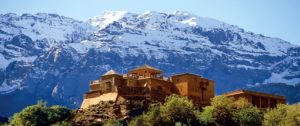
Earlydeparture from Marrakech heading to the direction of Damnate and its beautiful fields of olive trees. After driving towards the natural bridge of ImiNifrid you will stop for a mint tea and enjoy the view. All this road is unique by its greenish valleys and amazing scenarios. You will have plenty of chances of taking photos. Visit of a traditional water mill in the region. Berber lunch near the waterfalls. Return to Marrakesh in the evening after a wonderful day out of Marrakech.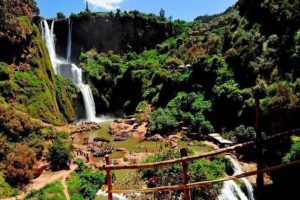
Situated on the Atlantic coast 2.5hrs from Marrakech is the laid-back fishing village of Essouira, famous for its Gnaoua music and artistic scene. Many local and foreign artists have settled here continuing the vibe that attracted visitors such as Jimmy Hendrix and Cat Stevens (Yousuf Islam) in the 1960’s.
Once an old Portuguese fishing village, Essouira is a perfect place for those who wish to wander the souks for wooden carvings that it is famous for, to stop and enjoy fresh seafood and local wine whilst watching the fisher men come in with their daily catch. For a more active alternative the kite and board surfing is excellent here and there is horse riding, camel riding and golf available. 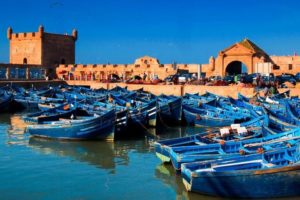
Experience the energy and essence of Fez as it comes to life after dark. Fez by Night tour reveals the captivating appeal of the medina and Ville nouvelle, and the vibrant life that exists within this traditional city. Start from Bab Boujloud, to the Jewish Mellah and through the gold souks to the Kings Palace. Promenade along the boulevards discovering the famous fountains of Fez and soak up the festive atmosphere of Fassis enjoying their own city after sunset.

This morning enter into the depths of the tanneries, observe weavers at their loom, engage with the copper workers employing traditional design techniques and discover hidden workshops where generations of artisans ply their individual trades and adapt century old techniques to a modern market. This artisanal tour is designed to give you an overview of production methods and step by step explanations as you go beyond the traditional medina tour to delve deeper into the world of the artisans of Fez. Meet the artisans themselves as you gain firsthand knowledge of the materials and the processes involved in their daily work. The tour finishes with a visit to Fez’ new artisanal school and exhibition gallery
Morocco is a place where music plays a large part in celebrating religious festivals, marriage and birth. Drums are seen and heard everywhere in Morocco and Fez is the place to make them.
We invite you both to spend a morning in a typical Fondouk(traders workspace) under the watchful eye of a drumming artisan teaching you how to make your own drums. You choose the sound of drum you prefer, pick out the skin, stretch and string your own instrument before painting it in your very own individual design. Finally a professional drummer will teach you how to play the drum Moroccan style so you can impress family and friends on your return. 
One cannot but help notice the different fashions that adorn the streets of the medina, from the western style dress to the more traditional kaftan style jelabas worn by men and women. This afternoon you will be accompanied by a seamstress through the dress makers’ souk to choose a celebratory kaftan design. You will need to select your materials, threads and beads from the vast array available in the souk and with your design prepared, have the perfect his and hers kaftans made for you – ready for collection the following day!

In this modern age of new world cosmetics we invite you into the world of ancient beauty secrets and where it all began. Participate in a 5 hour workshop that unearths traditional methods and natural beauty products that can easily be made in your own home by yourself or with friends. Start your day by shopping at the souk el henna to purchase ingredients and gain an overall explanation of the products that can be made from each one. We move on to our workshop, in a Moroccan Dar on the rooftop terrace, a space traditionally reserved for ‘women’s businesses. Sip Moroccan tea as you learn how to make and blend your own rhassoul and we take you through the traditional products including Argan oil, sabun bildi and eau de fleur with step by step instructions so that you understand the properties of the ingredients, how and why they are used and the benefits they each provide. We finish off the workshop with a visit to a medina hammam so that you can employ the techniques that you have learned and absorb yourself into the rituals and culture of the local Moroccan women

More than traditional Moroccan cooking, this class is a complete immersion into the Moroccan culture and family life. Spending time with our lovely local family in their beautiful riad, you will be encouraged to fully take part in the daily activity of shopping and preparing for a delicious traditional meal. This unique experience will take you to the local medina souk, the bread you make will be baked at the local faran, and your delicious feast will be shared with the family Moroccan style.
Your lesson will entail, shopping for seasonal vegetables and fruit, preserving lemons, making traditional Moroccan salads, bread-baking and the art of making the perfect mint tea – what you make will depend on the seasonal produce and can be decided on prior to your souk visit.
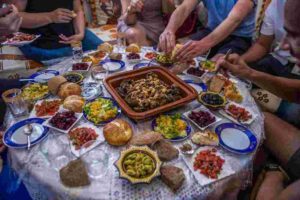
Find your way through the streets and souks with a local Fez food expert. Start by exploring the fresh food souks, then on to the honey souk to taste an array of delicious honeys, their flavours and properties and find out why honey is so important in Moroccan cooking and Islamic culture. From the honey souk, visit traditional farnatchis, the spice El attarryia and the henna souk. Try traditional Moroccan foods including dried meats, milawi, harsha, briwats, spicy sardines, and fresh goat cheese, finishing off with a visit to a traditional Moroccan tea house.
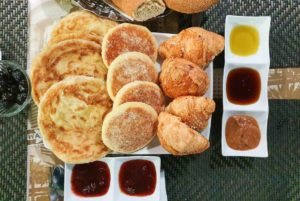
Indulge your sweet tooth and learn how to prepare Moroccan patisseries as well as discovering this important cultural practice. A Moroccan feast is not complete without sweets; in particular, patisseries play an integral role in everyday life in Fez. The ancient city is famous for its diverse and traditional sweets with a multitude available every day at the local souks. Spend the day with a Moroccan family to prepare 4 to 5 different traditional Fassi Moroccan sweets.

Depart Fez for the Middle Atlas Mountains to visit one of Morocco’s leading boutique fromagerie’s, La Pommerai. The private property is one of the first to be officially certified organic in the region and is set against a backdrop of apple and orange orchids. Taste exquisite, hand-crafted and artisanal cheeses and olive oils which are cold pressed as well honey raised and processed into a variety of pure honey. Here we’ll have a Dada on hand (female cook), who’ll be teaching us how to make khobz(Moroccan bread) in a traditional clay faran. A delicious meal of farm produce will be served, along with our own homemade breads and the local cheeses.

This morning depart for Fez via Moulay Idriss and the ancient Roman ruins of Volubilis, a day spent in the past, seeing ancient architecture and eating age old recipes, a feast fit for Anthony and Cleopatra themselves! Find beautiful mosaic floors, uncovered and brought to light by the archaeologists that work this partly excavated site. It was developed from 3rd century BCE onwards as a Phoenician and later a Carthaginian settlement. The town fell to local tribesmen in 285 and was never recovered by the Roman Empire. Constantly uncovering this city beneath the sands of time, now exclusively a Moroccan project runs by Moroccan archaeologists. Following a tour of this stunning historic site from the 3rd century BC and its many intact and colourful mosaics, enjoy the tranquillity of a local farm in the shadow of the ancient ruins while sampling traditional Roman recipes as recorded in the Latin texts of Apicius and Cato.
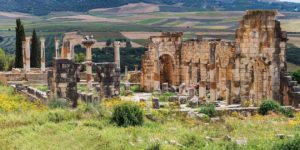
The Middle Atlas region offers many hidden delights including spectacular views of cedar and cork forests and delightful & hilarious Barbary apes. A short hike into the cedar forests with a mountain guide to participate in the Monkey Watch programme. Enjoy the crystal air of the mountains while you discover the rustic Berber towns of Immouzer, Ifrane and Azrou.
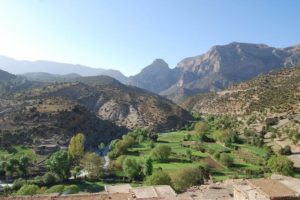
info@specialmorocco.com
07 rue Tarablous, QI 80000
AGADIR, MOROCCO

Morocco is one of those types of destinations that can be visited year-round. You have to understand the geography of the country in order to choose the best time to visit Morocco. Taking into account that you have vast desert regions, probably those should not be visited during the peak summer months such as July and August.
Also, knowing that Morocco has most part of its territory with mountains above 10.000 feet and up to 14.000, you will surely encounter snow in highlands above 4200 feet. So, expect snow during the months of November until February. Overall we can say that Morocco is amazing and can be visited from January until December, but the ultimate best times to visit Morocco are during April, May, September, October, and November.
Tourists have been visiting Morocco for years and Moroccans have well-earned reputation for warmth and kindness toward visitors. Moroccan cities are generally very safe, especially in area where tourists frequent. Morocco is very well secured, Police in every location, there is so many checking points, this is what makes Morocco safe and 100% secured to make sure everybody are safe and comfortable in Morocco. Morocco generally has a very low crime rate. Travelers will be safe in Morocco if they take sensible precautions that would apply to any tourist destination around the world.
Travel insurance should be obtained before leaving your country of origin. It is not compulsory to purchase it. Local hospitals have limited diagnostic capability. Private clinics can be expensive, evacuation can cost a lot, luggage can disappear, so insurance is a good idea.
You can relax and wear whatever is familiar, comfortable, and best suited for you during your holidays. Morocco is very tolerant and welcoming to visitors, and you’re not expected to act or look like a Moroccan. Longer shorts and shirts are fine for men. Concerning women, it’s a good idea to bring a scarf to cover bare shoulders and arms in rural areas.
It’s not easy to get Moroccan Dirham outside the country as it is a closed currency. Those who succeeded have paid heavy commissions for banks.
There are ATMs everywhere in the country, exchange points, banks, and many businesses/shops/restaurants nowadays accept cards mostly with a 5% transaction fee. The best place to exchange money with high rate is the touristic areas.
The Moroccan Dirham (MAD) is the currency of Morocco. Made up of 100 centimes per unit, the currency is issued by the Bank Al-Maghrib (Morocco’s central bank). Historically, the Moroccan Dirham originates from the Byzantine Empire’s Drachm, and was used in Arabia and the Levant in pre-Islamic times. The name “Dirham” stems from the Roman word “denarius” .
Credit cards are widely used in Morocco in hotels, many shops, restaurants, and cafes. Most stores in markets accept credit cards. The most common types of credit cards used in Morocco are Visa, Master Card, and American Express.
Visitors to Morocco must have a passport valid for at least 6 months beyond the scheduled return date to enter Morocco and you can obtain a visa from Morocco Consulate before departure. Also, entry visa is available upon arrival Morocco airports against USD 27 per passport for specific nationalities and need to check before.
Some nationalities don’t need a visa to visit Morocco for the purpose of tourism for up to 3 months such as United States of America, Canada, United Kingdom, Australia, Denmark, Netherlands, New Zealand, and Switzerland. For more info and details on entry visa to Morocco please check with the Moroccan consulate or embassy at your country
It is always recommended for travelers who wish to have their own supply of cigarettes and alcohol with them in Morocco to purchase them upon arrival.
There are duty free shops in the airports in Casablanca, Marrakech, Agadir, Fez, Tangier and Rabat. Tourists are allowed to purchase up to 3 liters of alcohol and up to 200 cigarettes on arrival.
English and French are studied in school all over Morocco. This is why most Moroccans, who live in the cities, speak or understand at least some English words or phrases, and most of Moroccans are speaking French well. Fewer Moroccans can speak Italian, Spanish, and German; however, professionals in the tourism sector are accustomed to visitors who cannot speak Arabic. They speak enough English and many other languages to fulfill the needs of most travelers. Many travelers enjoy their stay in Morocco without learning a single word of Arabic; however, it is always good to learn a few Arabic words to expressing greetings or thanks. If you are planning to visit some places other than popular tourist destinations, it is advisable to learn some Arabic phrases. Generally, Moroccans are friendly and are happy to help anyone, especially foreigners and tourists, even if there is a language barrier.
Many people in the tourism sector depend on tips, as a major part of their income. Therefore, tipping is considered customary in Morocco. It is a customary attitude for expressing ones satisfaction of good services rendered to him by staff on duty with him. We advise if you are willing to offer it, this would be great and if not, you are not obliged to do it.
– The same as many hotels all around the globe, the check-in time in most hotels in Morocco is around midday, 1 or 2 PM. If you arrive in the hotel late at night or in the early morning, you may have to pay for an extra night to get to your room immediately without having to wait until the normal check-in time.
Accommodations for travellers in Morocco fall across a broad range—everything from world class luxury to simple hostel accommodations are available. The nicest hotels compare well with luxury hotels anywhere, coming from international hotel chains like Movenpick, Hilton, Four Seasons, and Sofitel. A step down from these is a variety of local hotels that ranges from luxurious to simple. Moroccan hotels have their own rating system that loosely classifies them on a 5-star scale; however, this scale is different from international standards used elsewhere.
Moroccans are well known all over the world for their tolerance and hospitality; however, it is always polite to ask permission before taking a photograph of people, especially women, and stores or products. Photography is non-permitted around army bases, airports, dams and bridges. In most places where photography is prohibited there will be signs to notify you.
Non-Muslims are generally welcome to visit and access Hassan 2 mosques in Casablanca except when they are being used for prayer, on Friday and during the five prayers of the day. Tourists are not allowed to enter any other mosque at any time. Only outside visit is possible.
Most of the monuments, historical sites, and museums in Morocco open from 9 AM until 6 PM. During Ramadan, the holy month of the Islamic calendar, be aware that these hours will change significantly.
Most of the shops in Morocco open from around 9 AM and stay open until 10 PM; however, many shops, cafes, and restaurants especially in main cities like Marrakech, Casablanca, Fez, Agadir, and Rabat stay open much later and some facilities and shops are open 24 hours a day in touristic areas. During Ramadan, the holy month of the Islamic calendar, opening hours may change significantly with shops closed during the middle of the day and staying open much later. Medina Souk in Fez closes Friday Morning.
There is a public transit system in Morocco that uses a rail to link the main towns and buses for inner-city trips. Small private and group tours will typically use large vans and sedans. Medium to large motor coaches is used for larger group holidays.